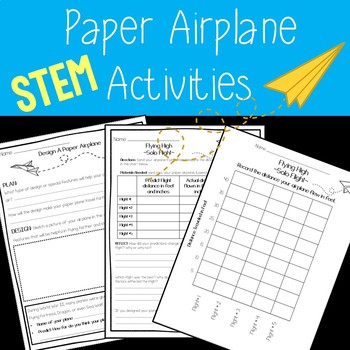End of Year Activity: Paper Airplane STEM Activities with Lesson Plan
- PDF
What educators are saying
Also included in
- This bundle provides engaging aviation themed Math, Science, and ELA activities to keep students learning and having fun at the end of the year! Begin with having students learn about 1 of 27 famous aviators and complete a Mini-Biography Poster and do a Gallery Walk. Then introduce the science behPrice $5.50Original Price $7.00Save $1.50
Learning Objective
Students will design, create, and test a paper airplane design.
Description
This STEM mini-unit provides students with an opportunity to explore several science and math concepts with fun, engaging paper airplane activities. Students have the opportunity to learn about how things fly, learn how the design of a plane affects its flight, create a paper airplane, and test the paper airplane's ability to fly.
This no-prep print and go mini-unit is a great end of year activity! Keep students engaged and learning while having fun!
*************************************************************************************************************
Here's a peek at what students will do during this mini-unit:
- Mini-lesson about how things fly and the four forces that affect flight (gravity, lift, drag, and thrust).
- Evaluate 3 paper airplane designs to determine how the design affects the 4 forces (gravity, lift, drag, and thrust).
- Design and create a paper airplane
- Complete 5 or 10 trials to test how far the plane will fly either as a solo flight or with a partner.
- Graph the data collected from measuring each trial flight in either feet or meters.
- Analyze the flight data and determine how the paper airplane can be redesigned to improve flight distance.
Optional Activities:
- Students can repeat the activity with a new, improved paper airplane design.
- Students convert distance traveled from feet into inches and find the average distance traveled in inches.
*************************************************************************************************************
The following is included in this resource:
Page 2 – Lesson Ideas and Suggestions
Page 3 – 4 – How Do Things Fly – Mini-lesson on the forces that affect an object flying with Answer Key
Page 5 – 6 – Evaluating Paper Airplane Design With Answer Key – Students evaluate how different designs are affected by the four forces
Page 7 – Basic Paper Airplane Folding Instructions – Basic Dart Plane
Page 8 – Design A Paper Airplane – Students make a plan for their paper airplane and then create it.
Pages 9 – 10 – Solo Flight Recording Chart for 5 Flights in Feet or Meters
Pages 11 – 12 – Solo Flight Recording Chart for 10 Flights in Feet or Meters
Pages 1 3 – 20 – Graphs to Record Solo Flights in Feet or Meters
Pages 21 - 22 – Duo Flight Recording Chart for 5 Flights in Feet or Meters (Students work with a partner and record distance of both paper airplanes.)
Pages 23 - 24 – Duo Flight Recording Chart for 10 Flights in Feet or Meters
Pages 25 – 32 – Graphs to Record Duo Flights in Feet or Meters
Page 33 – Reflecting on My Paper Airplane Design – students evaluate the design of their paper airplane and how it affected flight; then students design a new and improved paper airplane.
Page 34 – 35 – Measurement Conversion – Feet and Inches activity for 5 flights or 10 flights
************************************************************************************************************
Need more End of Year Activities? You may be interested in these -
End of Year Digital Class Memory Book for Google Slides™- 3rd, 4th, & 5th Grades
End of Year Bundle: Paper Airplanes, Famous Aviators, & Bonus Activities
I Need My Monster Read Aloud with STEM, ELA, and Math Activities
4th Grade Mixed Review Math Task Cards - Print and Digital Version for Google Classroom
************************************************************************************************************
Don't forget that leaving feedback earns you points toward FREE TPT purchases. I love that feedback!
Also, FOLLOW ME and be notified when new products are uploaded.
As always, please contact me with any questions!
Happy Teaching!
Eileen Jarman






